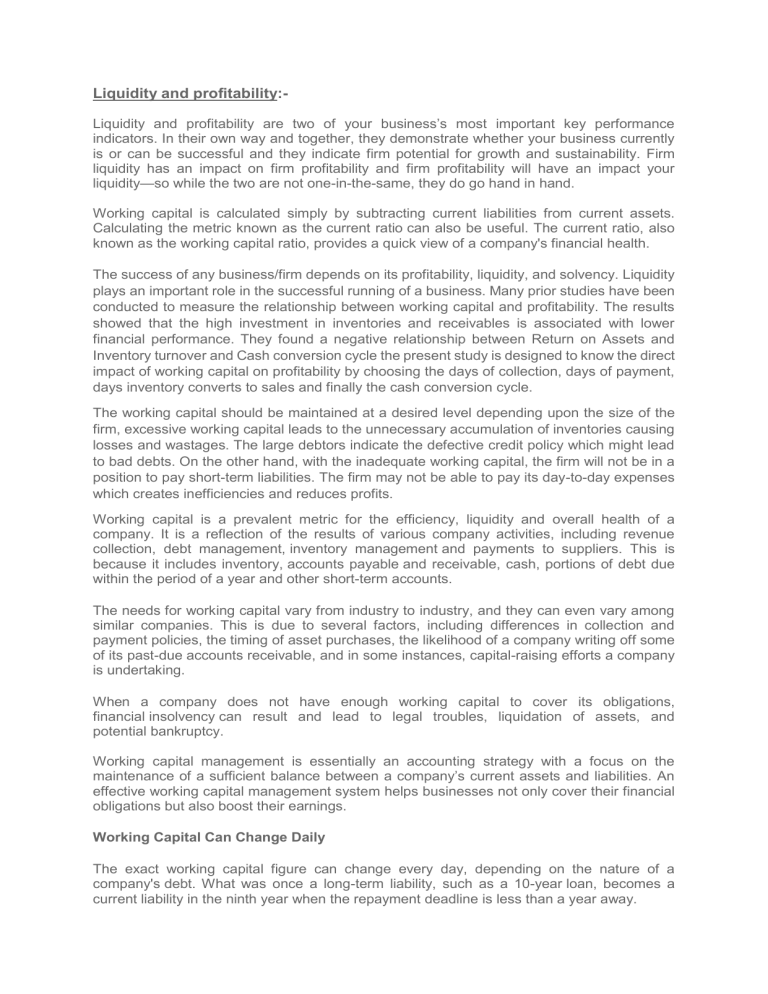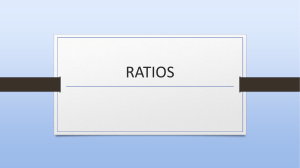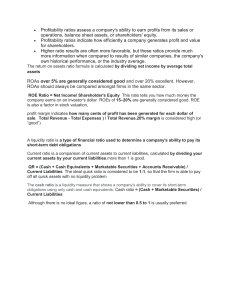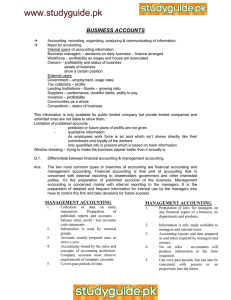
Liquidity and profitability:Liquidity and profitability are two of your business’s most important key performance indicators. In their own way and together, they demonstrate whether your business currently is or can be successful and they indicate firm potential for growth and sustainability. Firm liquidity has an impact on firm profitability and firm profitability will have an impact your liquidity—so while the two are not one-in-the-same, they do go hand in hand. Working capital is calculated simply by subtracting current liabilities from current assets. Calculating the metric known as the current ratio can also be useful. The current ratio, also known as the working capital ratio, provides a quick view of a company's financial health. The success of any business/firm depends on its profitability, liquidity, and solvency. Liquidity plays an important role in the successful running of a business. Many prior studies have been conducted to measure the relationship between working capital and profitability. The results showed that the high investment in inventories and receivables is associated with lower financial performance. They found a negative relationship between Return on Assets and Inventory turnover and Cash conversion cycle the present study is designed to know the direct impact of working capital on profitability by choosing the days of collection, days of payment, days inventory converts to sales and finally the cash conversion cycle. The working capital should be maintained at a desired level depending upon the size of the firm, excessive working capital leads to the unnecessary accumulation of inventories causing losses and wastages. The large debtors indicate the defective credit policy which might lead to bad debts. On the other hand, with the inadequate working capital, the firm will not be in a position to pay short-term liabilities. The firm may not be able to pay its day-to-day expenses which creates inefficiencies and reduces profits. Working capital is a prevalent metric for the efficiency, liquidity and overall health of a company. It is a reflection of the results of various company activities, including revenue collection, debt management, inventory management and payments to suppliers. This is because it includes inventory, accounts payable and receivable, cash, portions of debt due within the period of a year and other short-term accounts. The needs for working capital vary from industry to industry, and they can even vary among similar companies. This is due to several factors, including differences in collection and payment policies, the timing of asset purchases, the likelihood of a company writing off some of its past-due accounts receivable, and in some instances, capital-raising efforts a company is undertaking. When a company does not have enough working capital to cover its obligations, financial insolvency can result and lead to legal troubles, liquidation of assets, and potential bankruptcy. Working capital management is essentially an accounting strategy with a focus on the maintenance of a sufficient balance between a company’s current assets and liabilities. An effective working capital management system helps businesses not only cover their financial obligations but also boost their earnings. Working Capital Can Change Daily The exact working capital figure can change every day, depending on the nature of a company's debt. What was once a long-term liability, such as a 10-year loan, becomes a current liability in the ninth year when the repayment deadline is less than a year away. Current Assets Can Be Written Off Working capital (as current assets) cannot be depreciated the way long-term, fixed assets are. Certain working capital, such as inventory, may lose value or even be written off, but that isn't recorded as depreciation. Assets Can Be Devalued While it can't lose its value to depreciation over time, working capital may be devalued when some assets have to be marked to market. That happens when an asset's price is below its original cost, and others are not salvageable. Two common examples involve inventory and accounts receivable. Inventory obsolescence can be a real issue in operations. When that happens, the market for the inventory has priced it lower than the inventory's initial purchase value as recorded in a company's books. To reflect current market conditions and use the lower of cost and market method, a company marks the inventory down, resulting in a loss of value in working capital. Accounts Receivable May Be Written Off Meanwhile, some accounts receivable may become uncollectible at some point and have to be totally written off, representing another loss of value in working capital. Working capital is the amount of available capital that a company can readily use for day-to-day operations. It represents a company's liquidity, operational efficiency, and short-term financial health. To calculate working capital, subtract a company's current liabilities from its current assets. A positive amount of working capital means a company can meet its short-term liabilities and continue its day-to-day operations. The current ratio (current assets divided by current liabilities) is a liquidity ratio often used to gauge short-term financial well-being; it's also known as the working capital ratio. The negative relationship between the profitability and the average collection period, the lower the average collection period higher will be the profitability. The correlation between average payment period and profitability should be low, which shows a positive relationship if there is an increase in payment period it leads to an increase in profitability. It is found that the cash conversion cycle decreases it will lead to an increase in profitability of the firm, and managers can create a positive value for the shareholders which indicates that it has been maintained. The results of this study show that there is a strong relationship between the working capital and profitability of the firms. It means if the financial managers keep an eye on the liquidity it will lead to profitability. So, it is recommended that Companies should always maintain a sound collection policy and it is further suggested that managers can create value for their shareholders by reducing the number of days accounts receivable, increasing the number of days accounts payable and inventories to a reasonable minimum.





